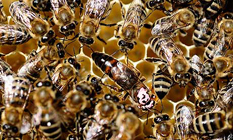Can cities save our bees?
 For the past 10 years, colonies of bees have decreased at an alarming rate. A phenomenon called colony collapse disorder has been killing them off en masse, and beekeepers have been quick to alert the public about their high hive mortality. The bees are threatened by new and intensive farming practices (heavy usage of technologies such as pesticides and chemical fertilisers, plant growth regulators, and methods such as mono-cropping and organised irrigation), climate change and the arrival of the Asian hornet. In recent years, the mortality rate of bees has quadrupled.
For the past 10 years, colonies of bees have decreased at an alarming rate. A phenomenon called colony collapse disorder has been killing them off en masse, and beekeepers have been quick to alert the public about their high hive mortality. The bees are threatened by new and intensive farming practices (heavy usage of technologies such as pesticides and chemical fertilisers, plant growth regulators, and methods such as mono-cropping and organised irrigation), climate change and the arrival of the Asian hornet. In recent years, the mortality rate of bees has quadrupled.The disappearance of bees endangers the beekeeping profession and threatens agriculture and the food supply (according to French scientists from INRA and the CNRS, 35% of world production of fruits, vegetables and oilseeds depends on the activities of the pollinators). Environmentalists and beekeepers, using data gathered by many toxological studies, are fighting against big chemical companies in order to prohibit the use of some products that can be lethal for bees, such as Gaucho and Regent TS.
But surprisingly, the industry has discovered that bees kept in urban areas are healthier and produce better honey. In rural areas, bees are victims of the disappearance of wild flowers, caused by excessive monoculture and the misuse of pesticides. As a consequence, it is more and more common to see wild swarms finding refuge in cities, and beekeepers are regularly deciding to move their hives to city gardens and parks. Fewer pesticides and a greater biodiversity are helping bee colonies to thrive here.
Today, beehives are quietly buzzing in cities all over the globe: Chicago, Toronto, Paris, London and New York are cities where thousands of different species of plants are blossoming in the gardens and parks. Honey produced in the cities is of a better quality than that from the countryside. The cities are becoming a haven; they do not protect the bees from everything, but they offer them a break.
This year is the International Year of Biodiversity and cities are being encouraged to reintroduce a bit of nature on to the streets. Actions range from the creation of gardens and the arrangement of rooftops for bees, to the reduction of pesticides. Bees can only benefit from this kind of initiative.
In the UK, Natural England, an agency that advises the government on environmental issues, has launched a plastic beehive to install at home. In the US, Chicago was the first city to act on behalf of bees: the city hall hosts a hive on its planted roof, thanks to the program Green Roofs. In New York, in 2010, beekeepers finally got the right to own hives in the city. In France, they are found both at the top of the Paris and Lille operas, above the rooftops of theatres, in parks, like in Luxembourg park, as well as in the courtyards of ordinary citizens, or on their balconies.
Everyone can now take part in a course about beekeeping and learn how to become a perfect urban beekeeper. Like Jacqueline and Michel, both retired, from Paris, a lot of people have started owning their own hives. “At first I was preparing my retirement and I wanted to find a hobby, but now we visit schools, we want people from the cities to get to know this fantastic animal, without which we cannot live. The purpose is that everyone leaves being aware of the precariousness of the situation.”
Beyond the protection of bees, it was discovered that the insects can reinforce the social bond in cities. That is why some beekeepers organise meetings where fellow beekeepers, artists, the public and tourists are invited and are in constant interaction. In this same spirit, the Parisian graphic beekeeper, Olivier Darné, installed in 2008 what he says is “an unusual refuge for two earthlings and 100,000 bees”. His art project, The Mooner, contains several hives with movable frames, which can accommodate up to 100,000 bees.
“The aim was to multiply the human senses, sounds, smells, images and to discover proximity with the bees, in order to get to know them,” explains the artist. The space is designed “like a decompression airlock from the urban living that gives time to contemplate urban, human and animal, between anxiety, fear and fascination”.
In front of an intensive agriculture, which exploits the bees, and facing the danger of their disappearance, a global bee-friendly movement is growing. This movement agrees with Albert Einstein, who supposedly once said: “No more bees, no more pollination … no more men.”
You can return to the main Market News page, or press the Back button on your browser.

